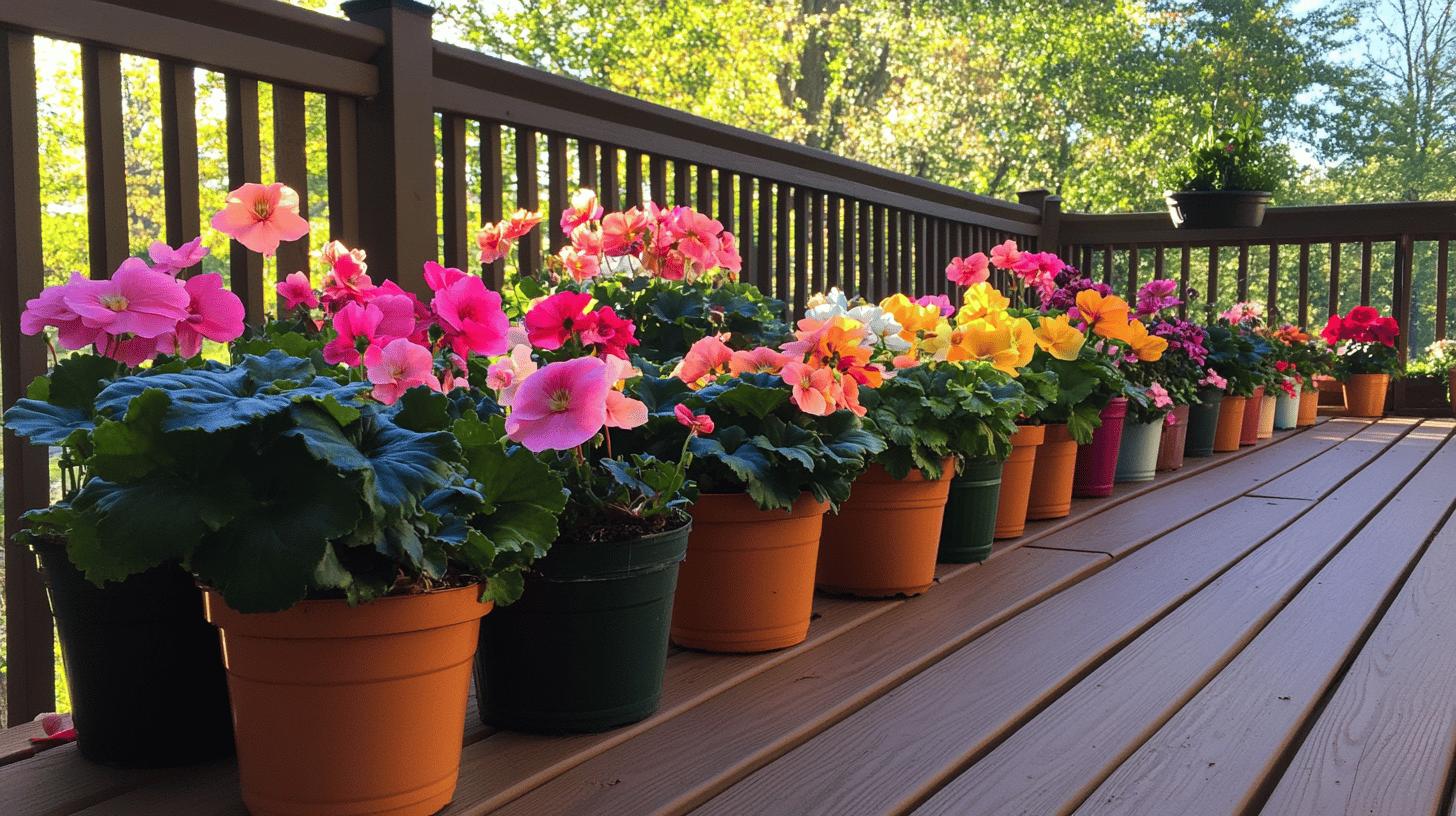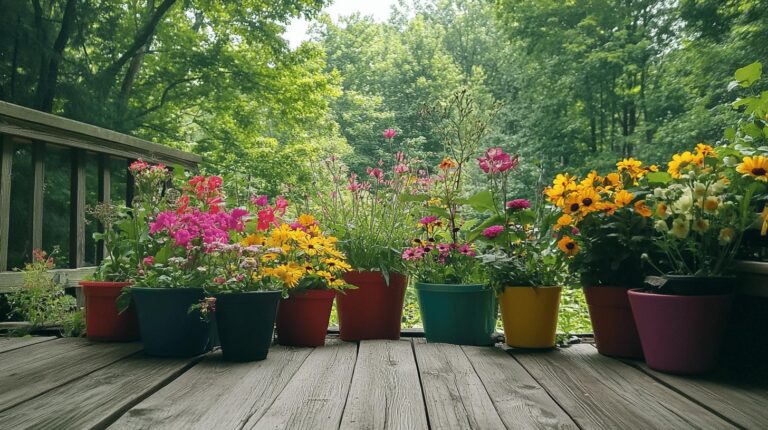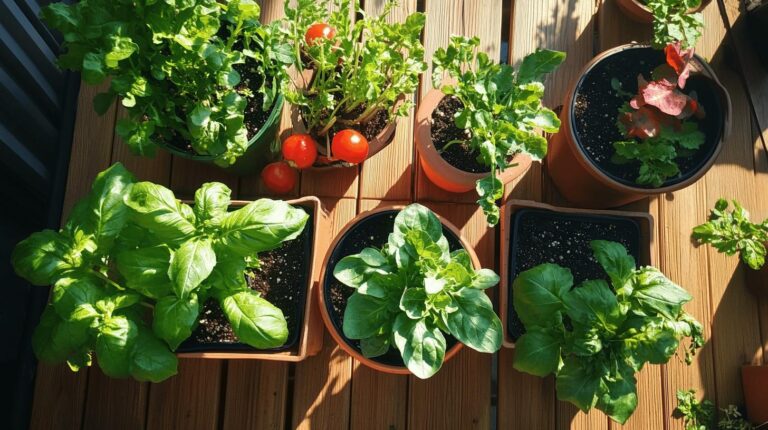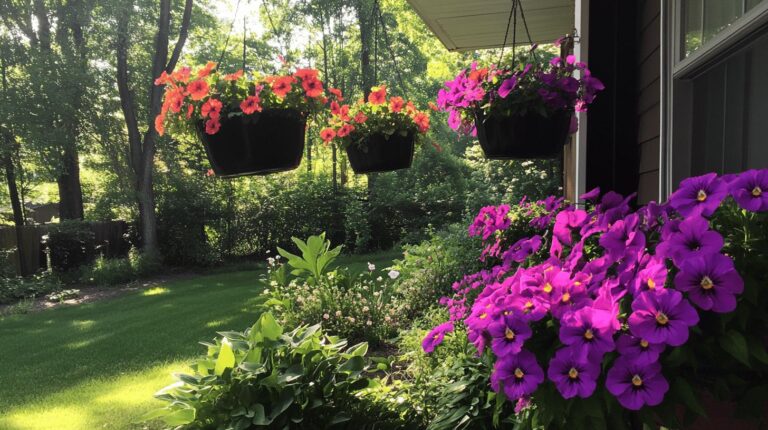Begonias for Containers: Vibrant Choices for Your Garden
Ever thought about using begonias to make your garden containers pop? These vibrant beauties can turn any humble pot into a dazzling display with an easy touch of elegance. The key lies in selecting the right types for your containers. You’ll find that tuberous and semperflorens begonias, with their lush blooms and leaves, are perfect choices. Each variety brings its unique flair, with colors and shapes as diverse as a painter’s palette. Let’s explore how these delightful plants can transform your garden into a visual feast.
Best Begonias for Containers
When it comes to selecting begonias for container gardening, understanding the different types can help you make the best choice for your space. Tuberous Begonias, with their large, showy blooms, are a favorite for adding dramatic flair to pots. Semperflorens Begonias, often referred to as Wax Begonias, offer a more compact growth habit and continuous flowering, making them perfect for smaller containers. Additionally, fibrous, hardy, and rhizomatous begonias each bring unique qualities to container setups, from vibrant foliage to resilience in varying conditions.
Some begonia varieties stand out for their striking appearance and robust performance in containers. Nonstop Red is renowned for its continuous blooms that provide a splash of color throughout the growing season. The T-Rex Painter’s Palette captivates with its bold, artistic foliage, while the Amstel Blitz impresses with its prolific flowering and rich hues. These varieties not only enhance the aesthetic appeal of containers but also thrive in various light conditions, ensuring versatility in placement.
- Nonstop Red: Known for continuous, vibrant red blooms.
- T-Rex Painter’s Palette: Features bold, decorative leaves.
- Amstel Blitz: Offers abundant colorful flowers.
- Solenia ‘Dusty Rose’: Tuberous hybrid with frilly rose-colored blooms.
- ‘Double Up White’: Features pure white, fully double blossoms.
Incorporating these begonia varieties into your container garden can transform any space into a vibrant display of color and texture. Whether placed on a patio or nestled in a shaded corner, these begonias provide a dynamic mix of blooms and foliage that can elevate the visual impact of your outdoor area. Their ability to adapt to different light and weather conditions makes them a versatile choice for gardeners looking to create stunning container arrangements.
How to Plant Begonias in Pots
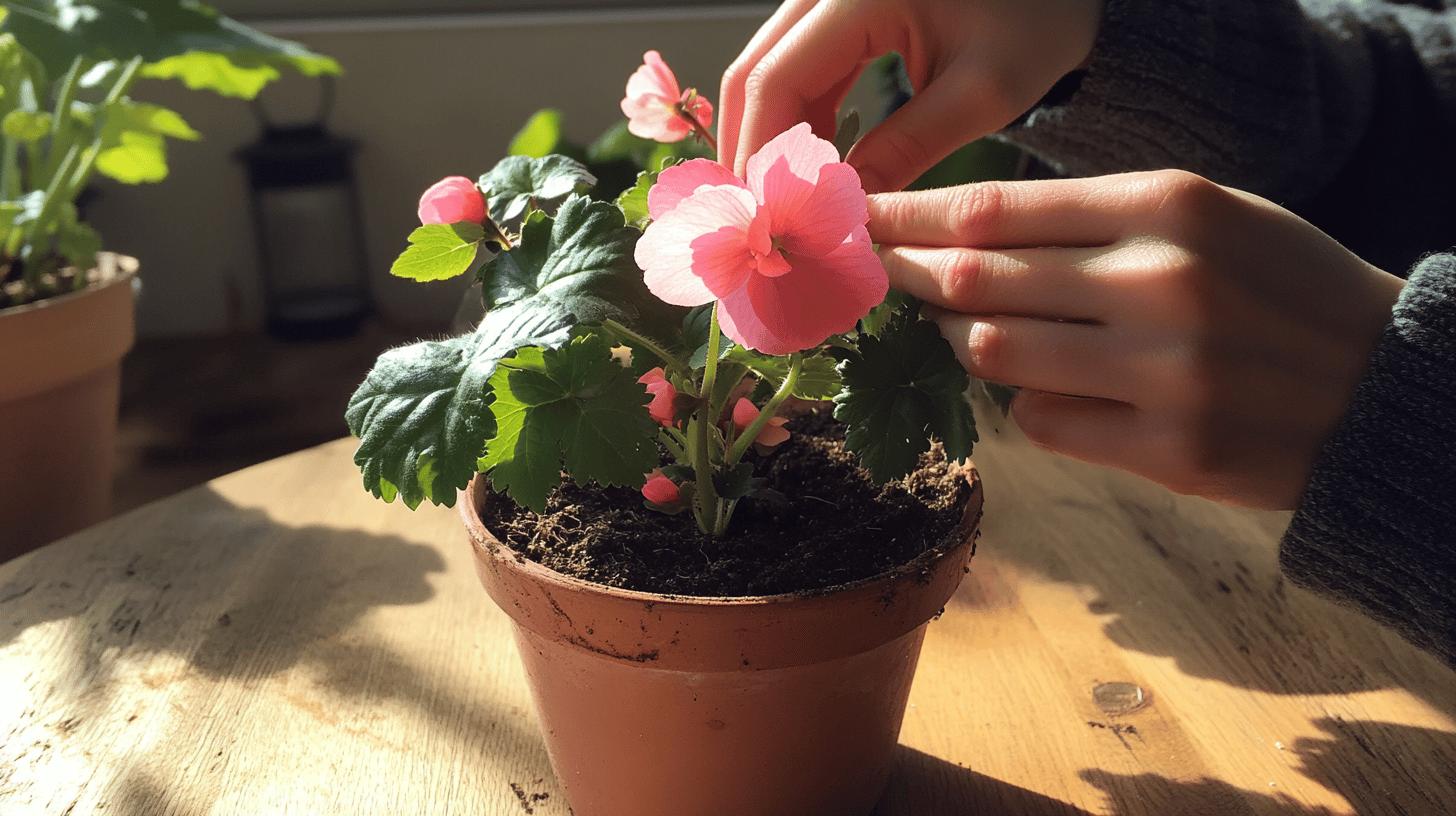
When planting begonias in pots, selecting the right container and soil is crucial for their growth and health. Begonias thrive in light, fluffy, and free-draining potting soil, as they are particularly sensitive to overwatering and soggy conditions. Start with small pots and gradually increase to 6-8 inch wide pots to allow the roots to develop without the risk of root rot. It’s essential to choose pots with drainage holes, ensuring excess water can escape and preventing root damage.
- Select the Pot: Begin with a small pot with drainage holes, gradually upgrading to a larger pot as the plant grows.
- Prepare the Soil: Use light, fluffy potting soil that drains well to prevent soggy roots.
- Potting the Plant: Gently place the begonia in the pot, ensuring the roots are covered with soil but not packed tightly.
- Watering: Initially water the plant lightly to help settle the soil around the roots.
- Positioning: Place the pot in an area with appropriate light, typically part shade or filtered sunlight for most begonia types.
To ensure healthy root development, monitor the moisture levels in the soil, watering only when the top inch feels dry. Avoid common mistakes such as overwatering and using pots without drainage, as these can lead to root rot and poor plant health. By following these steps, you’ll provide a nurturing environment for your begonias to flourish in their containers.
Care Tips for Container-Grown Begonias
Watering container-grown begonias requires a delicate balance. These plants prefer to be kept consistently moist but not waterlogged, as overwatering can lead to root rot. It’s best to water them when the top inch of soil feels dry to the touch. Begonias can tolerate brief periods of drought, so it’s crucial not to overdo it with watering. A consistent schedule, with adjustments for weather conditions and pot size, will help maintain their health and vibrancy.
- Use a balanced 20-20-20 fertilizer sparingly to provide essential nutrients.
- Fertilize every 2-4 weeks during the growing season for sustained growth.
- If leaf spotting occurs, reduce the frequency of fertilization immediately.
Light is another key factor in keeping begonias thriving. Most begonias prefer part shade or filtered sunlight, making them perfect for shaded patios or under tall trees. While some varieties can handle full sun, others, like rex begonias, may develop leaf scorch if exposed to too much direct sunlight. Position your containers where they receive morning sun and afternoon shade to mimic their natural growing conditions.
Addressing common care issues is vital for maintaining healthy begonias. Yellowing leaves often indicate improper watering, either too much or too little. Adjusting your watering routine can resolve this issue. Additionally, be on the lookout for leaf spotting, which may signal over-fertilization. In such cases, reduce or pause fertilizing and monitor the plant’s response. Regularly checking for signs of stress enables you to take prompt action, ensuring your begonias remain a vibrant addition to your garden.
Designing Begonia Container Arrangements
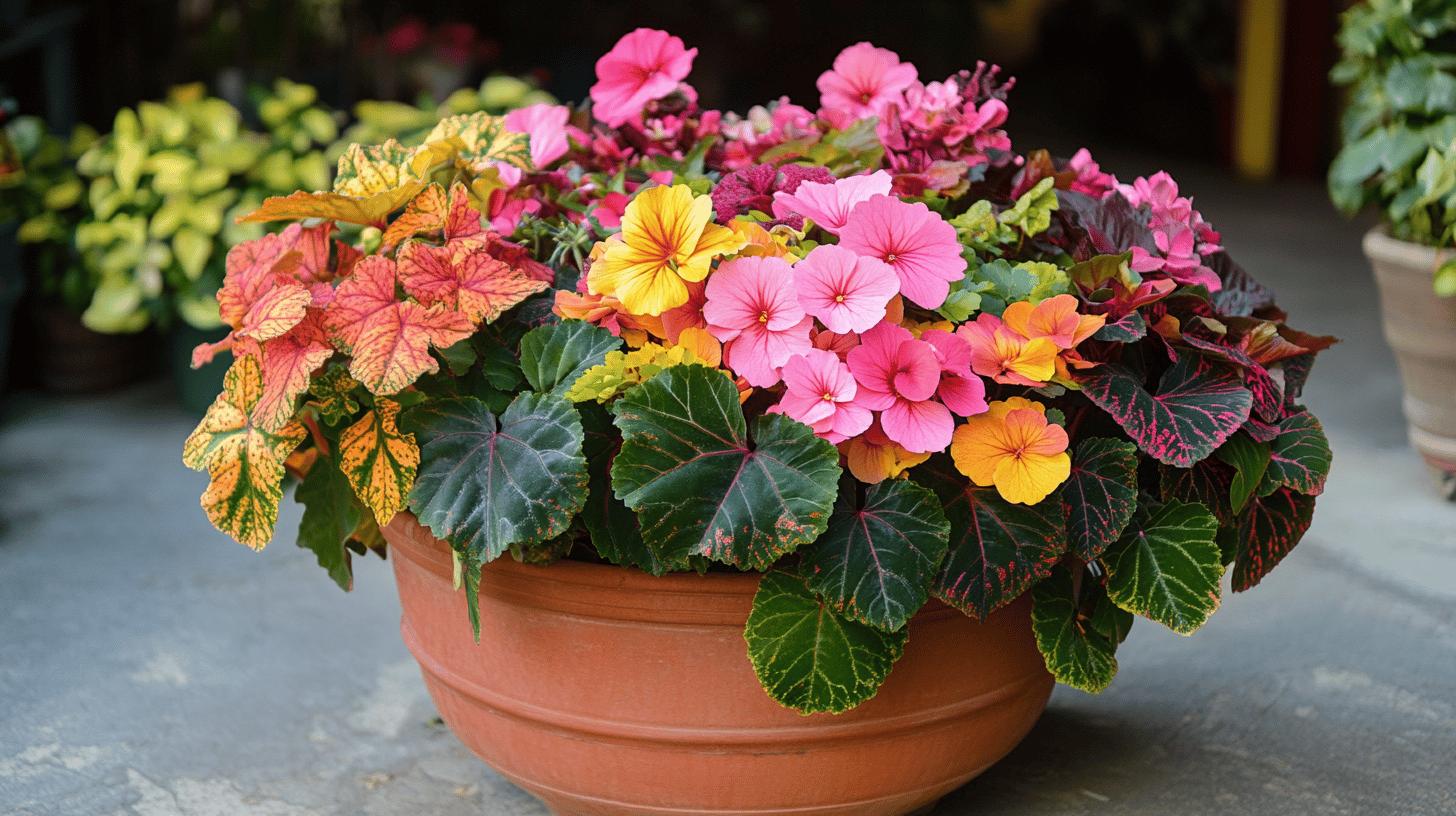
Mixing begonias with companion plants can elevate your container garden, offering vibrant displays that catch the eye. By pairing begonias with plants like coleus and golden lysimachia, you can achieve a dynamic blend of colors and textures. Begonias such as Nonstop Red and Amstel Blitz bring bold color contrasts to the mix, ensuring your arrangements stand out. This thoughtful combination not only enhances visual appeal but also allows for versatility in design, as these plants thrive under similar growing conditions.
- Nonstop Red with Coleus: Create a striking contrast with vibrant red blooms against the rich foliage of coleus.
- Amstel Blitz and Golden Lysimachia: Combine the bright flowers of Amstel Blitz with the trailing golden hues of lysimachia for a sun-kissed look.
- T-Rex Painter’s Palette with Hostas: Pair the bold foliage of T-Rex begonias with the lush leaves of hostas for a dramatic effect.
- Wax Begonias with Creeping Jenny: Use the delicate blossoms of wax begonias alongside the cascading greenery of Creeping Jenny for added texture.
Well-designed begonia arrangements can transform any garden space into a captivating scene. By experimenting with color contrasts and plant combinations, you can create containers that not only complement the surrounding environment but also draw attention with their beauty. The interplay of begonia blooms and companion foliage adds depth and character, making these arrangements a focal point in your outdoor space.
Seasonal Care for Begonias in Containers
When cold weather approaches, it’s crucial to prepare your begonias for winter to keep them thriving. Overwintering begonias, especially varieties like angel wing begonias, often involves bringing them indoors to shield them from frost. This not only protects the plants but also gives you a chance to enjoy their beauty indoors. To prepare, reduce watering as the plant enters dormancy, and prune back any overgrown or dead stems to maintain a tidy shape. This pruning helps the plant conserve energy throughout the cold months. If moving indoors isn’t an option, consider covering the pots with protective materials to ward off freezing temperatures.
- Prune Carefully: Trim back leggy or damaged stems to encourage a compact form.
- Indoor Transition: Gradually acclimate plants to indoor conditions to minimize shock.
- Frost Protection: Use frost blankets or burlap to cover outdoor pots, shielding them from harsh weather.
As spring arrives, it’s time to focus on rejuvenating your begonias for the growing season. Begin by gradually increasing water as the plant resumes active growth. Fertilizing with a balanced fertilizer can boost their energy and support lush foliage and blooms. Ensure your containers are placed in environments with the appropriate light conditions, as begonias typically prefer part shade to dappled sunlight. Keeping an eye on temperature fluctuations and ensuring proper airflow around the plants will help them flourish during the warmer months, rewarding you with vibrant displays throughout spring and summer.
Common Challenges and Solutions for Begonias in Containers
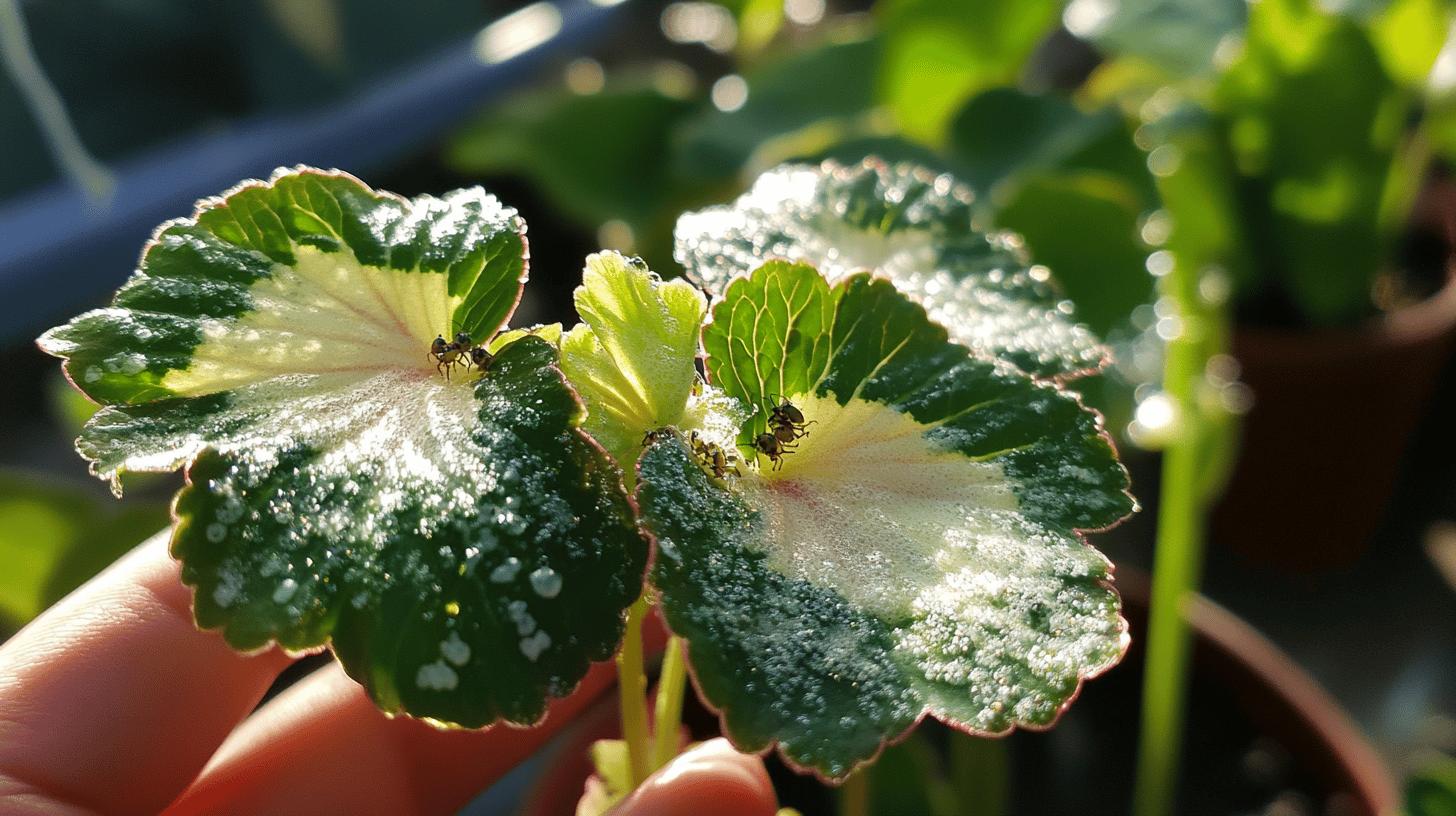
Dealing with pests is a common challenge when growing begonias in containers. Aphids, whiteflies, and mealybugs are frequent culprits, feeding on the plant’s sap and causing wilting and discoloration. Fortunately, several natural remedies can keep these pests in check. A simple mixture of soapy water sprayed on the leaves can effectively deter aphids. For broader pest control, neem oil serves as an excellent preventative measure, offering a natural solution to keep bugs at bay without the use of harsh chemicals.
Leaf spots are another issue that can plague begonias, often stemming from improper watering or excessive sun exposure. Overwatering can lead to fungal diseases that manifest as unsightly spots on the leaves. To address this, ensure that your begonias are planted in well-draining soil and water them only when the top inch of soil feels dry. Providing adequate shade, especially during the hottest parts of the day, can also prevent sunburn-related leaf spots, keeping the foliage healthy and vibrant.
Temperature tolerance is crucial for maintaining begonias in containers, as these plants can be sensitive to extreme weather. They thrive in moderate temperatures and can suffer from stress when exposed to excessive heat or cold. To protect your begonias, place them in a location where they receive filtered sunlight and are shielded from harsh winds. During colder months, consider moving them indoors or covering them to prevent frost damage. By monitoring environmental conditions and adjusting care routines accordingly, you can ensure that your begonias remain robust and flourishing.
Enhancing Outdoor Spaces with Begonias
Begonias are a fantastic choice for adding a splash of color and texture to shaded areas in your garden or patio. With their ability to thrive in low-light conditions, they are perfect for spaces that don’t get direct sunlight all day. Placing begonias in pots allows you to easily move them around your outdoor area, creating visually appealing focal points. Whether nestled under a tree or lining a shaded pathway, begonias bring vibrancy and life to otherwise overlooked spots.
- Hanging Arrangements: Use hanging baskets filled with trailing begonia varieties to add vertical interest to your patio.
- Layered Planting: Combine begonias with shade-loving plants like ferns and hostas for a lush, layered garden look.
- Colorful Borders: Line your garden paths or patio edges with potted begonias to create a colorful border that guides the eye.
Incorporating begonias into your outdoor spaces can dramatically transform the ambiance, making gardens and patios feel more inviting and lively. Their diverse range of colors and forms provides endless possibilities for creative expression. As they bloom, begonias infuse the environment with energy and charm, turning any corner of your outdoor area into a welcoming retreat.
Final Words
Choosing the best begonias for containers sets the stage for beautiful and effortless gardening. We explored popular varieties like Nonstop Red and T-Rex Painter’s Palette, which add vibrant splashes of color to any space. From selecting the right potting soil to caring tips, each step ensures these beauties thrive. As we incorporate begonias into our designs, their charm transforms every nook they touch, bringing life and personality. With patience and creativity, begonias for containers can turn any garden into a delightful retreat. Enjoy crafting your botanical masterpiece!
FAQ
Q: What are the best begonias for pots?
A: Tuberous and Semperflorens begonias, like Nonstop Red, T-Rex Painter’s Palette, and Amstel Blitz, are excellent for pots due to their vibrant colors and suitability for container gardening.
Q: Do begonias like sun or shade?
A: Begonias thrive in partial to full shade, as too much direct sunlight can damage them. They need filtered light to flourish.
Q: Do begonias do well in containers?
A: Yes, begonias adapt well to container gardening, offering a stunning display of flowers with manageable care, making them perfect for pots.
Q: What is the secret to growing begonias?
A: Successful growing of begonias involves well-draining soil, proper sun exposure, regular watering without over-saturating, and occasional feeding with balanced fertilizer.
Q: How do you plant begonias for containers?
A: Begin with a light, free-draining potting soil in a small pot, gradually moving to larger sizes. Pots must have drainage holes to avoid waterlogging.
Q: Can you leave begonias in pots over winter?
A: Overwinter begonias indoors by reducing watering and pruning for shape. This protects them from frost and maintains their health until spring.
Q: How can I identify different begonia varieties?
A: Understanding the main types—fibrous, tuberous, hardy, and rhizomatous—helps. Popular varieties include Wax, Angel Wing, and Painted-Leaf begonias, each with distinct leaf patterns and colors.
Q: Do you have any tips for designing begonia container arrangements?
A: Mix begonias with plants like coleus for contrast. Utilize Nonstop Red and Amstel Blitz for bold color combinations to create a visually appealing garden display.
